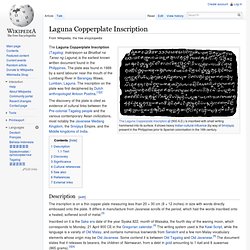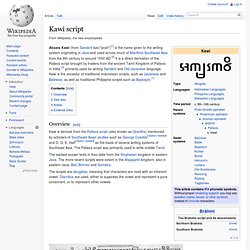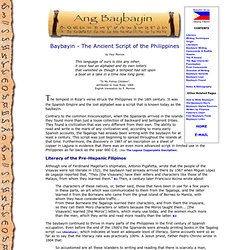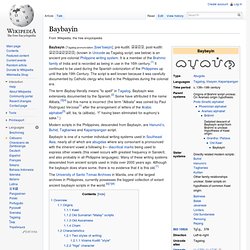

Laguna Copperplate Inscription. Description[edit] The inscription is on a thin copper plate measuring less than 20 × 30 cm (8 × 12 inches) in size with words directly embossed onto the plate.

It differs in manufacture from Javanese scrolls of the period, which had the words inscribed onto a heated, softened scroll of metal.[3] Inscribed on it is the Saka era date of the year Siyaka 822, month of Waisaka, the fourth day of the waning moon, which corresponds to Monday, 21 April 900 CE in the Gregorian calendar.[4] The writing system used is the Kawi Script, while the language is a variety of Old Malay, and contains numerous loanwords from Sanskrit and a few non-Malay vocabulary elements whose origin may be Old Javanese.
Some contend it is between Old Tagalog and Old Javanese.[5] The document states that it releases its bearers, the children of Namwaran, from a debt in gold amounting to 1 kati and 8 suwarnas (865 grams).[3][4] Text[edit] Discovery[edit] Significance[edit] Cultural references[edit] See also[edit] Kawi script. Aksara Kawi (from Sanskrit kavi "poet")[1] is the name given to the writing system originating in Java and used across much of Maritime Southeast Asia from the 8th century to around 1500 AD.[2] It is a direct derivation of the Pallava script brought by traders from the ancient Tamil Kingdom of Pallava in India,[3] primarily used for writing Sanskrit and Old Javanese language.

Kawi is the ancestor of traditional Indonesian scripts, such as Javanese and Balinese, as well as traditional Philippine scripts such as Baybayin.[1] Overview[edit] Kawi is derived from the Pallava script (also known as Grantha) mentioned by scholars of Southeast Asian studies such as George Coedès[citation needed] and D. G. E. The scripts are abugidas, meaning that characters are read with an inherent vowel. The literary genre written in this alphabet is called Kakawin. See also[edit] Notes[edit] External links[edit] Tiongson, Jaime F., (2008). Baybayin, The Ancient Script of the Philippines. "To My Fellow Children”, attributed to Jose Rizal, 1869 English translation by P.

Morrow The tempest in Rizal's verse struck the Philippines in the 16th century. It was the Spanish Empire and the lost alphabet was a script that is known today as the baybayin. Contrary to the common misconception, when the Spaniards arrived in the islands they found more than just a loose collection of backward and belligerent tribes. They found a civilization that was very different from their own. Although one of Ferdinand Magellan's shipmates, Antonio Pigafetta, wrote that the people of the Visayas were not literate in 1521, the baybayin had already arrived there by 1567 when Miguel López de Legazpi reported that, “They [the Visayans] have their letters and characters like those of the Malays, from whom they learned them.”
The baybayin continued to thrive in many parts of the Philippines in the first century of Spanish occupation. And Dr. Literature of the Ancient Filipinos The Consonants & Kudlíts . Baybayin. Baybayin (Tagalog pronunciation: [baeˈbaejɪn]; pre-kudlit: ᜊᜊᜌᜒ, post-kudlit: ᜊᜌ᜔ᜊᜌᜒᜈ᜔) (known in Unicode as Tagalog script; see below) is an ancient pre-colonial Philippine writing system.

It is a member of the Brahmic family of India and is recorded as being in use in the 16th century.[1] It continued to be used during the Spanish colonization of the Philippines up until the late 19th Century. The script is well known because it was carefully documented by Catholic clergy who lived in the Philippines during the colonial era. The term Baybay literally means "to spell" in Tagalog. Baybayin was extensively documented by the Spanish. Some have attributed it the name Alibata,[3][4] but this name is incorrect (the term "Alibata" was coined by Paul Rodríguez Verzosa[1] after the arrangement of letters of the Arabic alphabet[5] alif, ba, ta (alibata), “f” having been eliminated for euphony's sake. " )